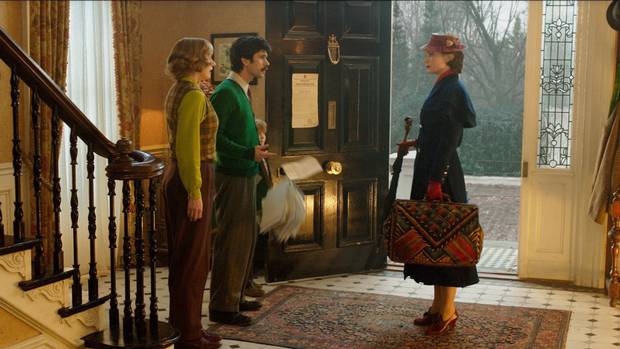Blueprints: "Mary Poppins Returns"
 Friday, January 18, 2019 at 10:30AM
Friday, January 18, 2019 at 10:30AM This week, Jorge explores how a movie reintroduces iconic characters to a new generation.

When a new Mary Poppins movie was greenlit, many sighed a sigh of relief when it was announced that it wouldn’t be a remake of the 1964 classic, but rather a sequel. This new story would bring Mary Poppins back to the Banks children, who are adults now, and would look after their own kids now. Perhaps she would straighten the mess in their lives once again.
The writers of this continuation faced the challenge of not only finding a new take inside the rest of author P.L. Travers’ series, but also reintroducing a character that has become a staple of cinema. A character who, because of the 60-year gap between movies, would be a completely different person. It turns out their answer was to treat it as if Mary Poppins had never left at all…
Mary Poppins Returns
Screenplay by: David Magee
Based upon the “Mary Poppins” stories by P.L. Travers
[You can read the entire script here.]
The production of Mary Poppins Returns had several obstacles to hurdle over. When audiences would sit down to watch the movie, they would have the 60-year-old legacy of one of the most beloved movie musicals in history following them into their seats. How does one make them forget about Julie Andrews’ Oscar-winning performance, and buy into Emily Blunt?
The physical production had to play a bigger part in making the movie visually feel like an extension of the original, with the heaviest weight falling on Blunt. But since the role of the writers was limited to the scope of the page, they could treat this sequel as a logical continuation of the story. They didn’t have to worry about the discrepancies, or the passing time. They didn’t need to reintroduce the characters.
 When a script introduces a new character, it usually describes him or her in some sort of detailed description: what they look like, what they are wearing, their age, and sometimes even things like their mood or background information. Mary Poppins Returns doesn’t. It trusts that we already know who these people are. Which, to be fair, speaking as a culture…we do.
When a script introduces a new character, it usually describes him or her in some sort of detailed description: what they look like, what they are wearing, their age, and sometimes even things like their mood or background information. Mary Poppins Returns doesn’t. It trusts that we already know who these people are. Which, to be fair, speaking as a culture…we do.
Although there are a lot of new additions to the cast in the sequel, the principal characters are older versions of people we met in the original: Ellen the housekeeper, Admiral Boom and his first mate, and of course, Jane and Michael Banks, now the adults in the story.
However, none of them get introduced as new characters in the script. They are just mentioned by name without any further detailed description. We already supposed to know who they are. But I do I think that pointing out how these people have changed since the last time we saw them would have been a good detail to add. After all, that’s what the movie is about in many regards. How Michael has aged into restraint and resignation. How Jane has maintained her bubbliness. How Ellen now looks like Julie Walters.

The only character that gets a slightly more elaborate introduction is, well, the titular role. “It is MARY POPPINS!” There is some description about her iconic clothes (“Dressed in a long coat, scarf, and eccentric hat…”), but nothing more. However, unlike with the Banks, this feels like enough. We know who Mary Poppins is. We know what she looks like. One of her main character traits is that she literally doesn’t change. Even if on the screen we will be seeing a different person, inside the world of the movie she is the same.
In fact, the first meeting between Mary and the Banks points directly to how she has not changed at all (“You haven’t aged at all!”), and references the previous movie with the codfish and giggling remarks. But this is as much reintroduction as the movie does between them. After this, they are up and running towards their new adventure.

Mary Poppins Returns builds onto a decades-long mythology and brings back beloved character into a new story. Although we know who they are (or the movie assumes we do), these characters have changed a lot through the years (except for Mary Poppins herself), and the script sadly doesn’t delve into these changes. I understand that decision, since the action and description lines are a part of the screenplay that audiences will never read. The movie conveys the changes through visuals or performances.
But as a script reader and script writers, I appreciate when screenwriters dig a little deeper into their introductions. After all, it’s our first look into who the characters are and, in this case, who they’ve become. I especially would have liked to know on paper that young Michael Banks grew into Ben Whishaw with a mustache.



Reader Comments (1)
I found your blog the best one and the knowledgeable one.Thanks for all of the information you have provided free dvd player windows is a best features and latest version i hope you sure like it.